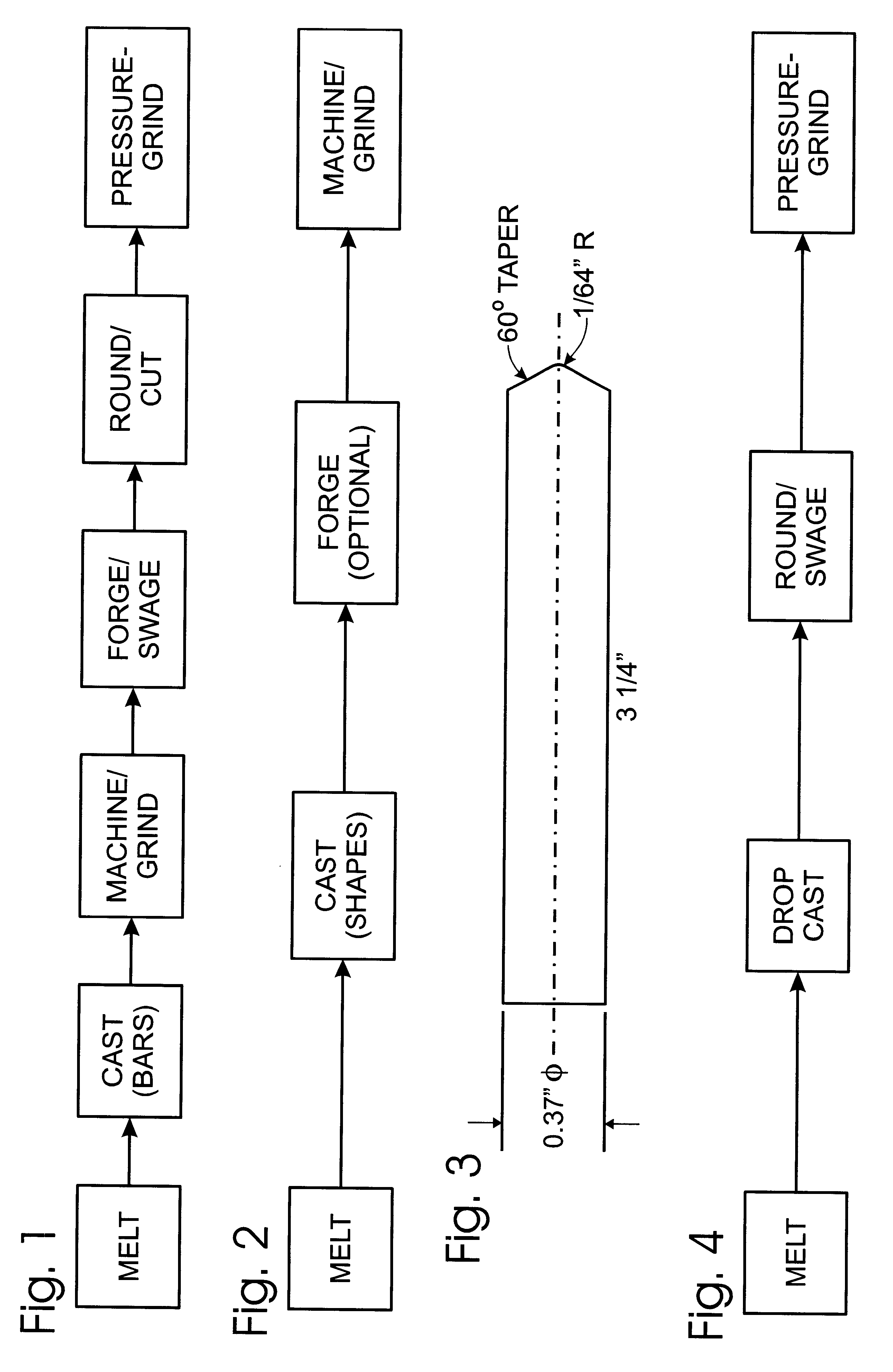Ductile, high-density, non-toxic shot and other articles and method for producing same
- Summary
- Abstract
- Description
- Claims
- Application Information
AI Technical Summary
Benefits of technology
Problems solved by technology
Method used
Image
Examples
example 2
The alloys of Table 1 ( 100 g each) were again prepared in the same way, but using -150 mesh ferrotungsten (80%W - 20%Fe) instead of pure W. Melting was much improved and complete dissolution of the ferrotungsten was achieved. During melting, it was observed that the Mn-bearing alloy was not as fluid as the other alloys. The alloy buttons were evaluated by performing Rockwell hardness tests on flat-ground areas of the buttons. Table 2 presents these results.
Densities were determined by weighing each button and by using water-displacement to estimate its volume. Table 3 presents measured densities for comparison against corresponding values calculated by the "rule-of-mixtures" method: ##EQU1##
where "f" indicates weight fraction of each element, which is then divided by its density in g / cm.sup.3.
Applying a permanent magnet to the buttons revealed that the ternary alloys (Alloys 1 A and 2 A) were ferromagnetic, whereas the quaternary alloy was non-magnetic. As in Example 1, ductility o...
example 3
The following alloys were produced from crushed (-1 / 4 inch) ferrotungsten (76% W), iron scrap (0.08% max. C), carbonyl Ni pellets and electrolytic Mn.
Batches of approximately 85 lb were prepared for each alloy, melted in a 100-lb, 150 -kw induction furnace, and cast at about 1500-1600.degree. C. into "green sand" molds to produce eight bars of each alloy approximately 1.0-inch diameter by 24 inches long. The cast bars were trimmed, abrasively cleaned and machined. (Portions of the molten alloys were also taken for shot-drop casting and near-net-shape casting which are presented later in Examples 4 and 5.)
Table 5 presents chemical compositions (based on actual analyses for tungsten), as-cast Rockwell B hardness, density and results of tests for ferromagnetism.
One cast bar of each alloy was machined to approximately 0.8-in. dia. and swaged at room temperature in a conventional two-die impact swage. Using incremental diameter reductions of 0.010-0.020 in., all four alloys were successf...
example 4
During the casting phase of Ex. 3, molten samples of all four alloys were directly cast into a variety of near-net shapes / sizes, including the following:
Alloys A, B, C and D were cast in 1"-dia..times.11 / 4" L alumina molds and in 5 / 32"-dia..times.6-12" L. evacuated Pyrex tubes. Alloy B was additionally cast in a graphite mold to produce three bars 0.37"-dia..times.31 / 4" L with conical ends (to simulate bullet shapes). These castings were subjectively evaluated for surface quality, porosity and density, and deemed to be of high quality. FIG. 2 presents a potential production process based upon these results, while FIG. 3 is a drawing of the actual near-net article produced in this example.
PUM
| Property | Measurement | Unit |
|---|---|---|
| Fraction | aaaaa | aaaaa |
| Fraction | aaaaa | aaaaa |
| Linear density | aaaaa | aaaaa |
Abstract
Description
Claims
Application Information
 Login to View More
Login to View More - R&D
- Intellectual Property
- Life Sciences
- Materials
- Tech Scout
- Unparalleled Data Quality
- Higher Quality Content
- 60% Fewer Hallucinations
Browse by: Latest US Patents, China's latest patents, Technical Efficacy Thesaurus, Application Domain, Technology Topic, Popular Technical Reports.
© 2025 PatSnap. All rights reserved.Legal|Privacy policy|Modern Slavery Act Transparency Statement|Sitemap|About US| Contact US: help@patsnap.com


